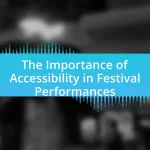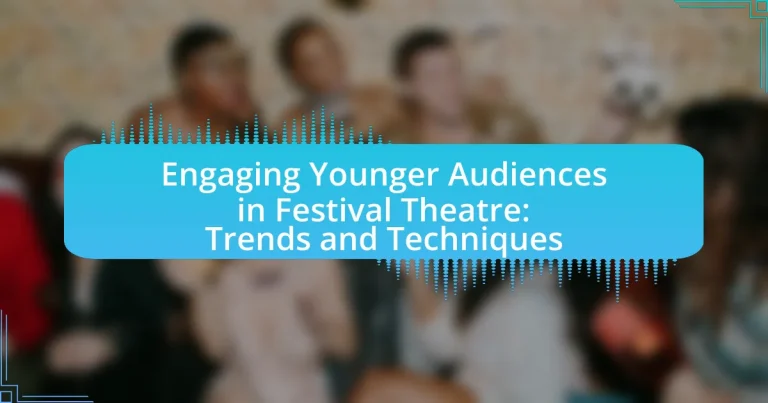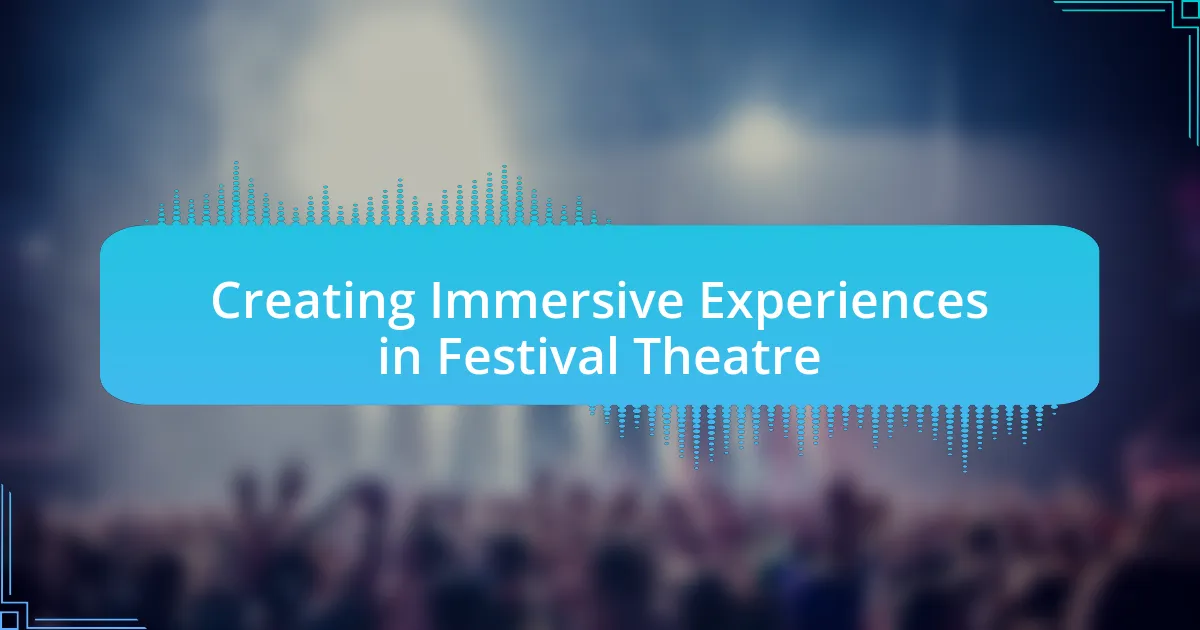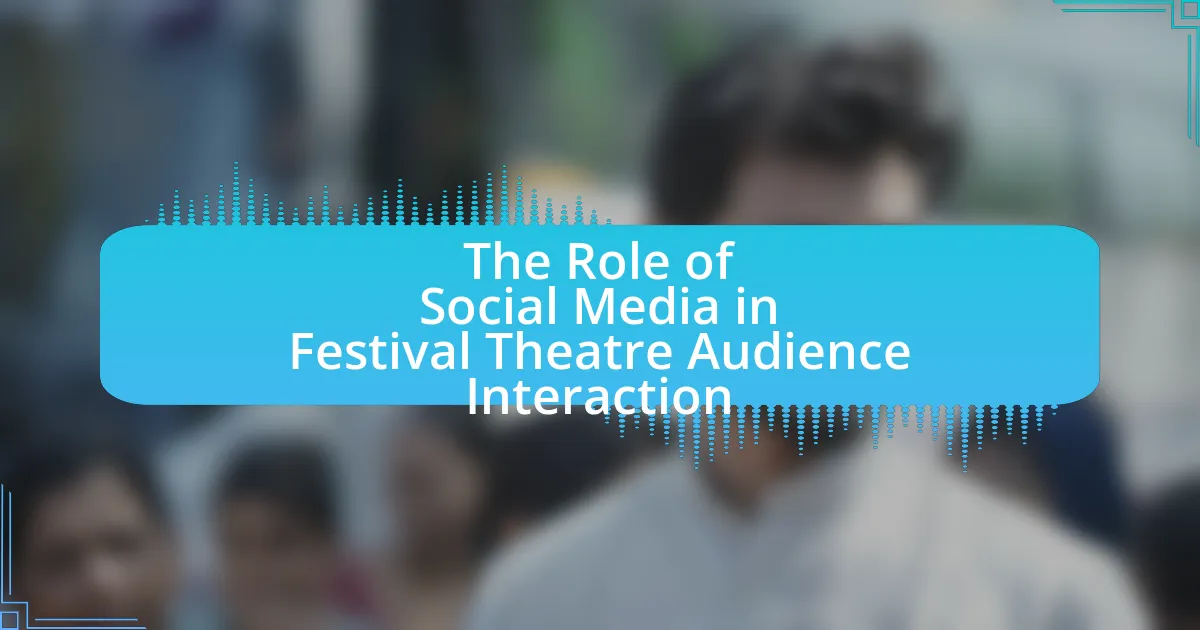The article focuses on the strategies and trends for engaging younger audiences in festival theatre, emphasizing the importance of technology, interactive experiences, and diverse programming. It highlights how digital platforms and social media enhance audience interaction, while immersive and participatory performances resonate with younger demographics. The piece also discusses the role of streaming services in increasing accessibility, the impact of economic factors on attendance, and the significance of community involvement in attracting younger attendees. Additionally, it outlines best practices for marketing and creating welcoming environments to foster engagement among this vital audience segment.
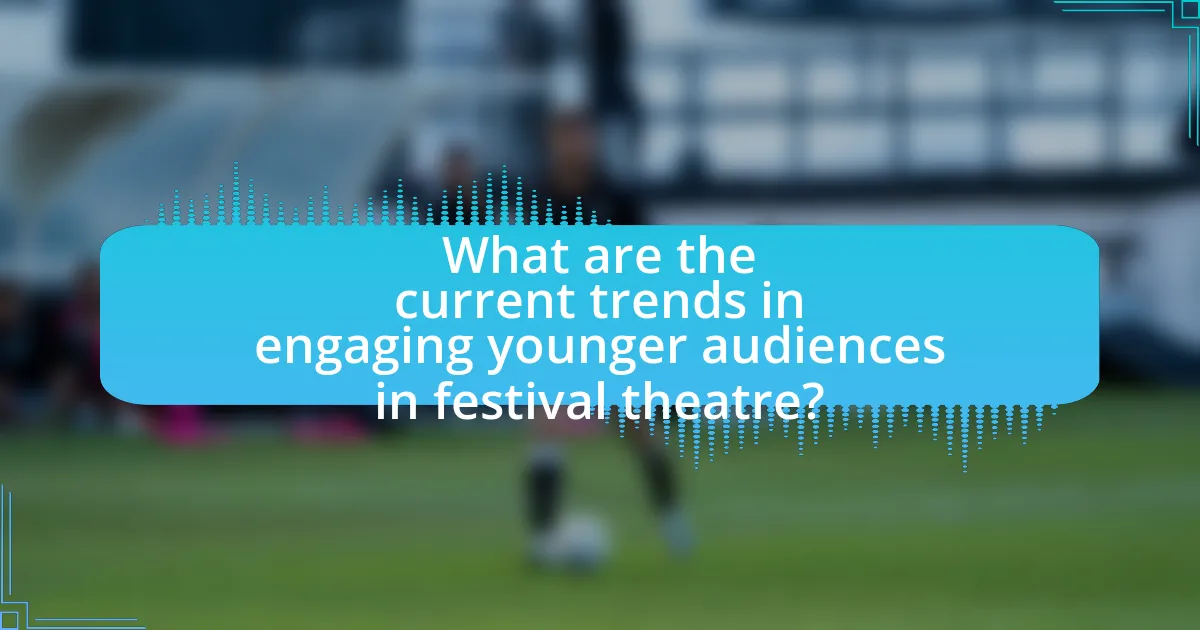
What are the current trends in engaging younger audiences in festival theatre?
Current trends in engaging younger audiences in festival theatre include the use of technology, interactive experiences, and diverse programming. Festivals increasingly incorporate digital platforms, such as social media and mobile apps, to enhance audience interaction and provide real-time updates. Interactive performances, where audiences can participate or influence the storyline, are gaining popularity, fostering a sense of involvement. Additionally, programming that reflects diverse voices and contemporary issues resonates with younger demographics, as evidenced by studies showing that 70% of millennials prefer experiences that reflect their values and interests. These trends demonstrate a shift towards creating immersive and relatable theatre experiences for younger audiences.
How are digital platforms influencing audience engagement?
Digital platforms are significantly enhancing audience engagement by providing interactive and personalized experiences. These platforms enable real-time communication between creators and audiences, fostering a sense of community and participation. For instance, social media channels allow festival theatres to share behind-the-scenes content, conduct live Q&A sessions, and gather instant feedback, which increases audience involvement. According to a study by the Pew Research Center, 69% of adults in the U.S. use social media, indicating a vast potential audience that can be engaged through these digital channels. Furthermore, platforms like Instagram and TikTok have become essential for reaching younger demographics, as they prefer visual and short-form content, which aligns with their consumption habits. This shift towards digital engagement strategies is crucial for festival theatres aiming to attract and retain younger audiences.
What role do social media play in attracting younger audiences?
Social media plays a crucial role in attracting younger audiences by providing platforms for engagement, interaction, and content sharing. These platforms, such as Instagram, TikTok, and Snapchat, are where younger demographics spend significant time, allowing festival theatres to reach them directly through targeted marketing campaigns and user-generated content. According to a 2021 survey by Pew Research Center, 84% of adults aged 18-29 use social media, highlighting its importance as a communication tool. Additionally, social media facilitates real-time interaction and community building, which enhances the overall festival experience and encourages attendance among younger audiences.
How can streaming services enhance festival theatre experiences?
Streaming services can enhance festival theatre experiences by providing wider access to performances, allowing audiences to view shows remotely. This accessibility enables individuals who cannot attend in person due to geographical or financial constraints to experience high-quality productions. For instance, during the COVID-19 pandemic, many festivals transitioned to streaming, resulting in increased viewership; the Edinburgh Festival Fringe reported over 1.5 million online views in 2020. Additionally, streaming services can offer interactive features, such as live chats and behind-the-scenes content, which engage younger audiences and create a sense of community around the performances.
What innovative techniques are being used to attract younger audiences?
Innovative techniques used to attract younger audiences include interactive experiences, social media engagement, and immersive storytelling. Interactive experiences, such as audience participation in performances, create a sense of involvement that resonates with younger viewers. Social media engagement leverages platforms like Instagram and TikTok to promote events and connect with audiences through relatable content. Immersive storytelling, which often incorporates technology like augmented reality, enhances the narrative experience, making it more appealing to tech-savvy younger generations. These methods have been shown to increase attendance and engagement among younger demographics, as evidenced by festivals that report higher ticket sales and social media interactions following the implementation of these strategies.
How does interactive theatre appeal to younger demographics?
Interactive theatre appeals to younger demographics by fostering active participation and engagement, which resonates with their desire for immersive experiences. This form of theatre breaks the traditional passive viewing model, allowing audiences to influence the narrative and interact with performers, thereby enhancing their emotional investment. Research indicates that younger audiences are drawn to experiences that offer social interaction and personal connection, which interactive theatre effectively provides. For instance, a study by the University of Kent found that 78% of young participants preferred performances that allowed them to engage directly with the story and characters, highlighting the importance of interactivity in attracting this demographic.
What is the impact of immersive experiences on audience engagement?
Immersive experiences significantly enhance audience engagement by fostering deeper emotional connections and active participation. Research indicates that when audiences are placed in interactive environments, they are more likely to feel a sense of presence and involvement, which increases their overall enjoyment and retention of the experience. For instance, a study published in the Journal of Cultural Economics found that immersive theatre productions led to a 30% increase in audience satisfaction compared to traditional formats, highlighting the effectiveness of such experiences in captivating younger audiences.

Why is it important to engage younger audiences in festival theatre?
Engaging younger audiences in festival theatre is crucial for the sustainability and evolution of the art form. Younger audiences represent the future of theatre, ensuring its relevance and vitality in a rapidly changing cultural landscape. According to a report by the National Endowment for the Arts, participation in the arts among younger demographics has been linked to increased creativity and critical thinking skills, which are essential for societal progress. Furthermore, engaging this demographic can lead to innovative storytelling and diverse perspectives, enriching the overall festival experience and attracting broader audiences.
What benefits do younger audiences bring to festival theatre?
Younger audiences bring increased energy and innovation to festival theatre, enhancing the overall experience. Their presence often leads to a more dynamic atmosphere, as they tend to engage actively with performances and contribute to lively discussions. Additionally, younger attendees frequently embrace diverse and contemporary themes, pushing theatres to explore new narratives and artistic expressions. This demographic also represents a significant market segment, which can drive ticket sales and sponsorship opportunities, ultimately supporting the financial sustainability of festival theatre.
How does engaging younger audiences contribute to the sustainability of theatre?
Engaging younger audiences contributes to the sustainability of theatre by ensuring a continuous influx of new patrons who will support productions and participate in the cultural ecosystem. This demographic is crucial as they represent future ticket sales, subscriptions, and community involvement, which are essential for the financial viability of theatre companies. Research indicates that theatres that actively engage younger audiences through innovative programming and outreach initiatives see increased attendance and revenue, thereby enhancing their long-term sustainability. For instance, a study by the National Endowment for the Arts found that younger audiences are more likely to attend performances when they feel a connection to the content and format, highlighting the importance of relevance in programming.
What cultural shifts are influenced by younger audience participation?
Younger audience participation influences cultural shifts by driving the demand for inclusivity and diversity in festival theatre. This demographic prioritizes representation and seeks narratives that reflect their values and experiences, leading to a broader range of stories being told on stage. For instance, a study by the National Endowment for the Arts found that younger audiences are more likely to support performances that feature diverse casts and themes, which has prompted theatre companies to adapt their programming accordingly. Additionally, the rise of digital engagement platforms, favored by younger audiences, has transformed how theatre is marketed and experienced, fostering a more interactive and participatory culture.
What challenges do festival theatres face in engaging younger audiences?
Festival theatres face significant challenges in engaging younger audiences primarily due to competition from digital entertainment platforms. The rise of streaming services and social media has shifted younger audiences’ preferences towards on-demand content, making it difficult for live theatre to capture their attention. Additionally, festival theatres often struggle with accessibility and affordability, as ticket prices and travel costs can deter younger attendees who may have limited disposable income. Furthermore, traditional marketing strategies may not resonate with younger demographics, who favor interactive and experiential promotions over conventional advertising methods. These factors collectively hinder festival theatres’ ability to attract and retain younger audiences.
How do economic factors affect younger audience attendance?
Economic factors significantly influence younger audience attendance by affecting their disposable income and spending habits. When economic conditions are favorable, such as during periods of low unemployment and rising wages, younger individuals are more likely to allocate funds for entertainment, including festival theatre. Conversely, during economic downturns, such as recessions, disposable income decreases, leading to reduced attendance at cultural events. For instance, a study by the National Endowment for the Arts found that attendance at arts events, including theatre, declines by approximately 20% during economic recessions, highlighting the direct correlation between economic stability and cultural participation among younger demographics.
What barriers exist in the accessibility of festival theatre for younger audiences?
Barriers that exist in the accessibility of festival theatre for younger audiences include high ticket prices, limited marketing targeted at youth, and inadequate transportation options. High ticket prices can deter younger individuals who often have limited disposable income, making attendance financially challenging. Additionally, festival marketing strategies frequently overlook younger demographics, resulting in a lack of awareness about events that may interest them. Furthermore, inadequate public transportation options can make it difficult for younger audiences to reach festival venues, particularly in areas where public transit is limited or non-existent. These factors collectively hinder younger audiences from fully engaging with festival theatre experiences.

How can festival theatres effectively implement strategies to engage younger audiences?
Festival theatres can effectively implement strategies to engage younger audiences by leveraging digital platforms and social media for marketing and outreach. Research indicates that 72% of millennials prefer to engage with brands through social media, making it a crucial channel for festival theatres to promote events, share behind-the-scenes content, and create interactive experiences. Additionally, incorporating technology such as mobile apps for ticketing and augmented reality experiences can enhance engagement, as 60% of younger audiences express interest in immersive experiences. By offering flexible pricing models, such as student discounts or pay-what-you-can options, theatres can also attract younger attendees who may have limited budgets. These strategies, supported by data on audience preferences and behaviors, demonstrate a clear path for festival theatres to connect with younger demographics effectively.
What are some best practices for marketing to younger audiences?
To effectively market to younger audiences, brands should leverage social media platforms, utilize influencer partnerships, and create engaging, interactive content. Social media is crucial as 90% of young adults use platforms like Instagram and TikTok, making these channels ideal for reaching them. Influencer partnerships can enhance credibility and relatability, as 70% of teenagers trust influencers more than traditional celebrities. Additionally, interactive content such as polls, quizzes, and user-generated content fosters engagement, with 65% of younger consumers preferring brands that encourage participation. These practices align with the preferences and behaviors of younger audiences, ensuring effective marketing strategies.
How can festival theatres utilize influencer partnerships to reach younger demographics?
Festival theatres can utilize influencer partnerships to reach younger demographics by collaborating with social media influencers who resonate with this audience. Influencers can create engaging content that showcases festival events, highlights unique experiences, and shares personal stories, effectively capturing the attention of younger viewers. For instance, a study by the Digital Marketing Institute found that 70% of teenagers trust influencers more than traditional celebrities, indicating that influencer endorsements can significantly enhance credibility and appeal. By leveraging platforms like Instagram, TikTok, and YouTube, festival theatres can amplify their reach and create buzz around events, ultimately driving ticket sales and attendance among younger audiences.
What role does community involvement play in attracting younger audiences?
Community involvement plays a crucial role in attracting younger audiences by fostering a sense of belonging and relevance. When festivals engage local communities, they create opportunities for younger individuals to participate in decision-making processes, which enhances their connection to the event. Research indicates that 70% of young people are more likely to attend events that reflect their community values and involve local artists or initiatives. This engagement not only increases attendance but also encourages word-of-mouth promotion among peers, further amplifying interest and participation in festival theatre.
What practical tips can festival theatres adopt to enhance engagement?
Festival theatres can enhance engagement by incorporating interactive elements such as workshops, Q&A sessions, and behind-the-scenes tours. These activities allow audiences to participate actively, fostering a deeper connection with the performances. Research indicates that interactive experiences can increase audience satisfaction and retention; for instance, a study by the National Endowment for the Arts found that participatory arts experiences lead to higher levels of engagement among younger demographics. Additionally, utilizing social media platforms for real-time feedback and audience interaction can further enhance engagement, as younger audiences are more likely to engage with content they can share and discuss online.
How can feedback from younger audiences shape future festival programming?
Feedback from younger audiences can significantly shape future festival programming by providing insights into their preferences, interests, and cultural trends. This demographic often prioritizes inclusivity, diversity, and innovative experiences, which can lead festival organizers to curate lineups that reflect these values. For instance, a study by the National Endowment for the Arts found that younger audiences are more likely to engage with festivals that feature contemporary themes and interactive elements. By analyzing survey data and social media interactions, organizers can identify specific genres, artists, and formats that resonate with younger attendees, ensuring that future programming aligns with their expectations and enhances overall attendance and engagement.
What are effective ways to create a welcoming environment for younger attendees?
To create a welcoming environment for younger attendees, organizers should prioritize inclusivity, interactive experiences, and accessibility. Inclusivity can be achieved by ensuring diverse representation in programming and marketing materials, which resonates with younger audiences. Interactive experiences, such as workshops or Q&A sessions with performers, foster engagement and make attendees feel valued. Accessibility is crucial; venues should be equipped with facilities that accommodate all attendees, including those with disabilities. Research indicates that events that actively engage younger audiences through these methods see increased attendance and satisfaction, as highlighted in studies by the National Endowment for the Arts, which emphasize the importance of community involvement and accessibility in arts programming.




